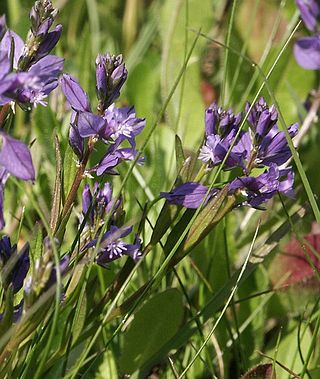
Polygala is a large genus of flowering plants belonging to the family Polygalaceae. They are commonly known as milkworts or snakeroots. The genus is distributed widely throughout much of the world in temperate zones and the tropics. The genus name Polygala comes from the ancient Greek "much milk", as the plant was thought to increase milk yields in cattle.
Eversmannia is a genus of flowering plants in the legume family, Fabaceae. It belongs to subfamily Faboideae. It includes four species native to temperate Eurasia, ranging from southern European Russia and the Caucasus through Central Asia to Xinjiang, Afghanistan, and Iran.
Rhinotropis subspinosa, synonym Polygala subspinosa, is a species of flowering plant in the milkwort family known by the common name spiny milkwort. It is native to the southwestern United States, where it grows in desert and plateau habitat. It is a perennial herb or small shrub growing in a clump no more than 25 centimeters tall. The stems have woody bases and green, thorn-tipped branches. The leaves are up to 3 centimeters in length and generally oval in shape. The flowers have winglike pairs of bright pink sepals and the keeled central petal is tipped with a yellowish beak, sometimes fringed at the tip.

Dyspessa is a genus of moths belonging to the family Cossidae. It was described by Jacob Hübner in 1820.

Dyspessa salicicola is a species of moth of the family Cossidae. It was described by Eduard Friedrich Eversmann in 1848. It is found in Greece, North Macedonia, Bulgaria, Romania, Ukraine, Russia and Turkey.
Semagystia is a genus of moths in the family Cossidae.
Cossulus irani is a moth in the family Cossidae. It is found in Iran.
Cossulus strioliger is a moth in the family Cossidae. It is found in Iran, Afghanistan, Tajikistan, Uzbekistan and Kyrgyzstan.
Cossulus bolshoji is a moth in the family Cossidae. It is found in Kazakhstan, Kyrgyzstan and Uzbekistan.
Chiangmaiana is a genus of the family Cossidae.
Yakudza vicarius is a moth in the family Cossidae and the only species in the genus Yakudza. It was described by Francis Walker in 1865, and reclassified in 2006. It is found in China, Russia and Japan.
Nedine is a genus of longhorn beetles of the subfamily Lamiinae, containing the following species:
Nedine subspinosa is a species of beetle in the family Cerambycidae. It was described by Wang and Chiang in 1999.

Nassarius subspinosus, common name the prickly dog whelk, is a species of sea snail, a marine gastropod mollusk in the family Nassariidae, the nassa mud snails or dog whelks.
Spinoberea subspinosa is a species of beetle in the family Cerambycidae. It was described by Maurice Pic in 1922.

Coenonympha orientalis is a small butterfly found in the Palearctic that belongs to the browns family. It is found in the Balkans.
Eversmannia is a genus of moths, belonging to the family Uraniidae.

Eversmannia exornata is a species of moth, belonging to the family Uraniidae. The species was described in 1837 by Eduard Friedrich Eversmann as Idaea exornata. It is native to Eastern Europe. The species has also been found within Western Siberia, as far east as the Altai Krai. This is the only moth within the Uraniidae family known to inhabit the West of Palearctic.
Eversmannia botschantzevii is a fungus in the genus Eversmannia that is native to Uzbekistan.
Eversmannia sogdiana is a fungus in the genus Eversmannia that is native to Tajikistan.






